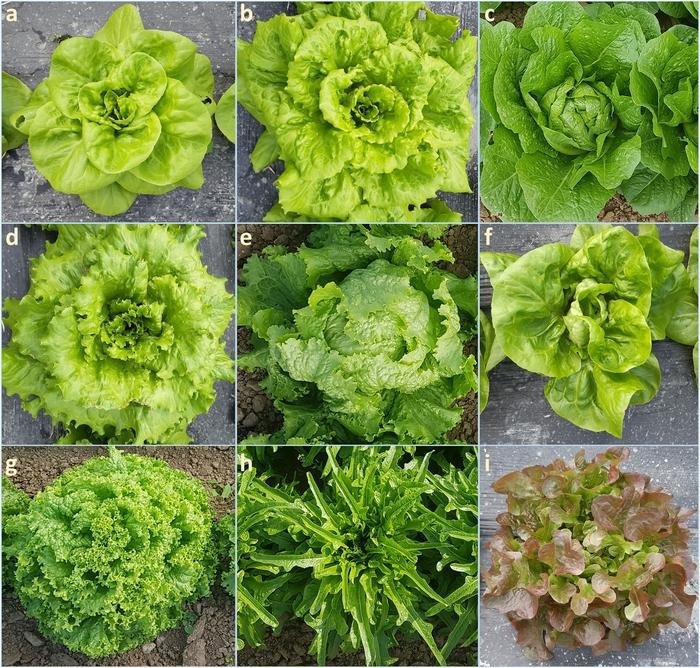To investigate the genetic diversity of a collection of 160 Lactuca accessions from 10 countries in Europe, America, and Asia, and to recognize genomic regions that underlie significant agronomic traits, the single primer enrichment technology (SPET), a novel high-throughput genotyping method, was used to sequence the lettuce for the first time.
 From top to bottom, left to right: Butterhead, Batavia, Cos, Crisp, Iceberg, Latin, Lollo, Loose Leaf, Oak Leaf. Image Credit: Charlotte Aichholz and Tizian Zollinger.
From top to bottom, left to right: Butterhead, Batavia, Cos, Crisp, Iceberg, Latin, Lollo, Loose Leaf, Oak Leaf. Image Credit: Charlotte Aichholz and Tizian Zollinger.
Single primer enrichment technology (SPET), a novel methodology, offers promising and affordable opportunities. In recent years, technologies to examine the genomic diversity of crops have made incredible progress. Numerous crop plants, including maize, poplar, oil palm, tomato, eggplant, and peach, have been used with SPET to date, demonstrating the technology’s effectiveness in genotyping germplasm collections and crossing populations.
A consortium of European investigators used SPET for the first time in lettuce (Lactuca sativa L.) as part of the European Evaluation Network (EVA) of the European Cooperative Programme for Plant Genetic Resources (ECPGR), with the goal of studying its genetic diversity and identifying genomic regions that underpin agronomically important traits.
Lettuce is a commercially important crop popular among consumers due to its high fiber content and low calories. It is also high in vitamin C, iron, folate, and other nutrients that are beneficial to health.
Given the lack of cost-effective options for genotyping in lettuce, the EVA Network decided to design a SPET panel for this crop, together with IGATech, and applied it to a collection of 155 accessions of Lactuca sativa and 5 of the closely related wild species Lactuca serriola.”
Pasquale Tripodi, Study Lead Author and Senior Researcher, CREA
ECPGR launched the EVA initiative in 2019 to increase knowledge of crop genetic diversity and use it to breed more resilient crops that can address agriculture's major challenges.
“The EVA Lettuce network is one of currently five crop-specific public–private partnerships, bringing together breeding companies, genebanks, and research institutes to jointly generate phenotypic and genotypic evaluation data for numerous accessions and landraces available in European genebanks,” notes Sandra Goritschnig, coordinator of the EVA initiative and co-author of the study.
The plant materials used in the research were selected in the frame of the EVA Lettuce Network and originated from the germplasm collections of four European genebanks: the Institute for Plant Genetic Resources ‘K.Malkov’ (Bulgaria), the Centre for Genetic Resources, the Netherlands, the Unité de Génétique et Amélioration des Fruits et Légumes, Plant Biology and Breeding, INRAe (France), and the Nordic Genetic Resource Center (NordGen) (Sweden).
The genotypes researched included cultivars, breeding materials, and landraces from 10 different countries in Europe, America, and Asia, as well as different horticultural types like Butterhead, Iceberg, Romaine, Batavia, and Crisp, and were phenotyped in multilocation field trials in three different countries.
Why was SPET used?
SPET, when contrasted to other genotyping methods, combines the benefits of arrays and high-throughput sequencing, and has a high potential to recognize new single-nucleotide polymorphisms (SNPs), which are differences in the genetic sequence that ascertain the diversity among individuals in a species.
Having a large number of SNPs increases our ability to understand the genetic diversity of a collection and investigate the function that some genomic regions play. In our case, we designed a SPET assay for 40,000 SNPs and succeeded in covering up to 96% of gene-rich regions, compared to previous studies in lettuce using different genotyping techniques, which covered only up to 27.6%. This demonstrates how effective SPET is.”
Pasquale Tripodi, Study Lead Author and Senior Researcher, CREA
Unlike other sequencing methods, using a fixed probes panel ensures the reproducibility of the assay across various labs. It also promotes the formation of larger scientific communities capable of leveraging interoperable markers.
The scientists were able to group the accessions by type and geographic origin, as well as pinpoint gene associations for seed color, leaf color, leaf anthocyanin content, and bolting time, thanks to the analyses of over 80,000 high-quality SNPs.
“We are very excited about this new application of SPET in lettuce, which confirmed previous findings, refined our knowledge of the genomic position of some agronomic traits, and demonstrated the power of SPET to investigate the genetic diversity of germplasm collections, thus allowing a better characterization of lettuce collections. The SPET panel will be a cost-effective tool for both breeders and researchers in lettuce,” concludes Goritschnig.
Source:
Journal reference:
Tripodi, P., et al. (2023) Development and application of Single Primer Enrichment Technology (SPET) SNP assay for population genomics analysis and candidate gene discovery in lettuce. Frontiers in Plant Science. doi.org/10.3389/fpls.2023.1252777.